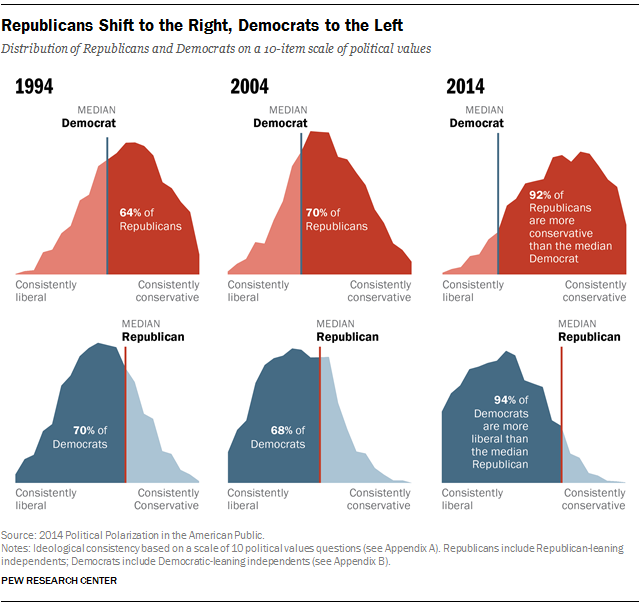Everybody interested in politics needs to look at this Pew article.
It’s fascinating and too complicated to summarize here, but basically we learn:
- Americans are increasingly sorted into think-alike communities that reflect not only their politics but their demographics. The result has been a rise in identity-based animus of one party toward the other that extends far beyond the issues. These days Democrats and Republicans no longer stop at disagreeing with each other’s ideas. Many in each party now deny the other’s facts, disapprove of each other’s lifestyles, avoid each other’s neighborhoods, impugn each other’s motives, doubt each other’s patriotism, can’t stomach each other’s news sources, and bring different value systems to such core social institutions as religion, marriage and parenthood. It’s as if they belong not to rival parties but alien tribes.
- This political sorting has roots in two simultaneous demographic transformations that America is undergoing. The U.S. is on its way to becoming a majority nonwhite nation, and at the same time, a record share of Americans are going gray. Together these overhauls have led to stark demographic, ideological and cultural differences between the parties’ bases.
- At the turn of the century, there was no partisan difference in the votes of young and old. But in recent elections, there has been a huge generation gap at the polls. And Democrats and Republicans have become much more ideologically polarized.
- The cleavages between the political tribes spill beyond politics into everyday life. Two-thirds of consistent conservatives and half of consistent liberals say most of their close friends share their political views. And liberals say they would prefer to live in cities while conservatives are partial to small towns and rural areas. In their child-rearing norms, conservatives place more emphasis on religious values and obedience, while liberals are more inclined to stress tolerance and empathy. And in their news consumption habits, each group gravitates to different sources.
-
Identity-based hyperpartisanship is thriving at a time when a majority of Americans tell pollsters they’d like to see Washington rediscover the lost art of political compromise. As ever, many Americans are pragmatists, ready to meet in the middle. Yet nowadays these Americans are the new silent majority. They don’t have the temperament, inclination or vocal cords to attract much attention in a media culture in which shrill pundits and 140-character screeds set the tone. Those most averse to political compromise are ideologically consistent conservatives and liberals, majorities of whom want their side to prevail.
-
The Democratic base, dubbed the “coalition of the ascendant” by journalist Ronald Brownstein, is often the coalition of the unengaged, especially during non-presidential elections. In 2014, for example, just 19.9% of 18- to 29-year-old citizens voted, a record low. The old turning out in force more than the young is nothing new – that seems hard wired into the human life cycle. This matters little when the generations vote alike, but it makes a huge difference when, as now, they don’t. Thus we have the alternating red and blue election outcomes of the recent past, with President Obama’s victories in the big turnout years of 2008 and 2012 playing hopscotch with the GOP romps in the low turnout midterms of 2010 and 2014. This in turn has contributed to a Washington that’s paralyzed by gridlock and a hothouse for the sort of rancor that can fire up the hyperpartisans but can also send nonpartisans farther off to the political sidelines. And so the cycle of mean-spirited, broken politics perpetuates itself.
- The public remains in a foul mood, frustrated by stagnant incomes, a shrinking middle class and gruesome global terrorism. Just 19% say they trust the government to do what’s right. Moreover, most Republicans and many Democrats say they believe that, on the issues that matter most to them, the other side is winning. And not since the early 2000s has a majority of the public said the nation is on the right track, making these past dozen years the longest sustained stretch of national pessimism since the onset of polling.
- Politics is never static, which means today’s state of affairs isn’t necessarily a template for the future. This campaign has already illuminated deep fissures not just between both parties but within them. A lot of political business will get transacted between now and November. No matter what the outcome, the political firmament is likely to look different next year.
And my favorite graphic in the bunch:

I think this is a windfall year and old paradigms don’t matter. We can explain what is going on by looking above. Numbers 6 and 7 explain Trump, as well as the many people I have heard who are pro-Sanders AND pro-Trump.
